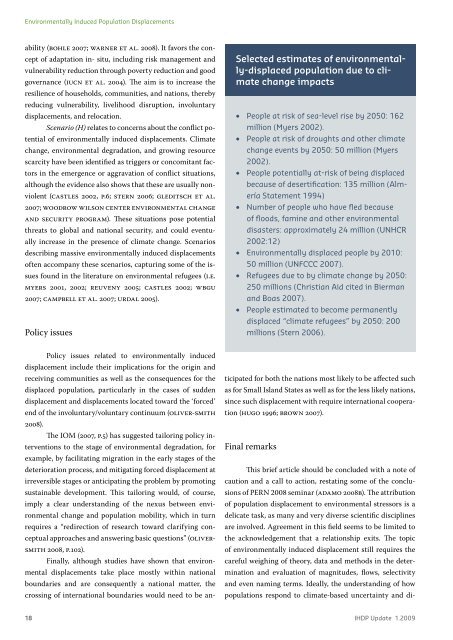Open - IHDP - United Nations University
Open - IHDP - United Nations University
Open - IHDP - United Nations University
Create successful ePaper yourself
Turn your PDF publications into a flip-book with our unique Google optimized e-Paper software.
Environmentally Induced Population Displacements<br />
ability (BohLE 2007; wArNEr Et AL. 2008). It favors the con-<br />
cept of adaptation in- situ, including risk management and<br />
vulnerability reduction through poverty reduction and good<br />
governance (IuCN Et AL. 2004). The aim is to increase the<br />
resilience of households, communities, and nations, thereby<br />
reducing vulnerability, livelihood disruption, involuntary<br />
displacements, and relocation.<br />
Scenario (H) relates to concerns about the conflict potential<br />
of environmentally induced displacements. Climate<br />
change, environmental degradation, and growing resource<br />
scarcity have been identified as triggers or concomitant factors<br />
in the emergence or aggravation of conflict situations,<br />
although the evidence also shows that these are usually nonviolent<br />
(CAstLEs 2002, P.6; stErN 2006; gLEdItsCh Et AL.<br />
2007; woodrow wILsoN CENtEr ENVIroNMENtAL ChANgE<br />
ANd sECurIty ProgrAM). These situations pose potential<br />
threats to global and national security, and could eventually<br />
increase in the presence of climate change. Scenarios<br />
describing massive environmentally induced displacements<br />
often accompany these scenarios, capturing some of the issues<br />
found in the literature on environmental refugees (I.E.<br />
MyErs 2001, 2002; rEuVENy 2005; CAstLEs 2002; wBgu<br />
2007; CAMPBELL Et AL. 2007; urdAL 2005).<br />
Policy issues<br />
Policy issues related to environmentally induced<br />
displacement include their implications for the origin and<br />
receiving communities as well as the consequences for the<br />
displaced population, particularly in the cases of sudden<br />
displacement and displacements located toward the ‘forced’<br />
end of the involuntary/voluntary continuum (oLIVEr-sMIth<br />
2008).<br />
The IOM (2007, P.5) has suggested tailoring policy interventions<br />
to the stage of environmental degradation, for<br />
example, by facilitating migration in the early stages of the<br />
deterioration process, and mitigating forced displacement at<br />
irreversible stages or anticipating the problem by promoting<br />
sustainable development. This tailoring would, of course,<br />
imply a clear understanding of the nexus between environmental<br />
change and population mobility, which in turn<br />
requires a “redirection of research toward clarifying conceptual<br />
approaches and answering basic questions” (oLIVErsMIth<br />
2008, P.102).<br />
Finally, although studies have shown that environmental<br />
displacements take place mostly within national<br />
boundaries and are consequently a national matter, the<br />
crossing of international boundaries would need to be an-<br />
Selected estimates of environmentally-displaced<br />
population due to climate<br />
change impacts<br />
• People at risk of sea-level rise by 2050: 162<br />
million (Myers 2002).<br />
• People at risk of droughts and other climate<br />
change events by 2050: 50 million (Myers<br />
2002).<br />
• People potentially at-risk of being displaced<br />
because of desertification: 135 million (Almería<br />
Statement 1994)<br />
• Number of people who have fled because<br />
of floods, famine and other environmental<br />
disasters: approximately 24 million (UNHCR<br />
2002:12)<br />
• Environmentally displaced people by 2010:<br />
50 million (UNFCCC 2007).<br />
• Refugees due to by climate change by 2050:<br />
250 millions (Christian Aid cited in Bierman<br />
and Boas 2007).<br />
• People estimated to become permanently<br />
displaced “climate refugees” by 2050: 200<br />
millions (Stern 2006).<br />
ticipated for both the nations most likely to be affected such<br />
as for Small Island States as well as for the less likely nations,<br />
since such displacement with require international cooperation<br />
(hugo 1996; BrowN 2007).<br />
Final remarks<br />
This brief article should be concluded with a note of<br />
caution and a call to action, restating some of the conclusions<br />
of PERN 2008 seminar (AdAMo 2008B). The attribution<br />
of population displacement to environmental stressors is a<br />
delicate task, as many and very diverse scientific disciplines<br />
are involved. Agreement in this field seems to be limited to<br />
the acknowledgement that a relationship exits. The topic<br />
of environmentally induced displacement still requires the<br />
careful weighing of theory, data and methods in the determination<br />
and evaluation of magnitudes, flows, selectivity<br />
and even naming terms. Ideally, the understanding of how<br />
populations respond to climate-based uncertainty and di-<br />
18 <strong>IHDP</strong> Update 1.2009
















